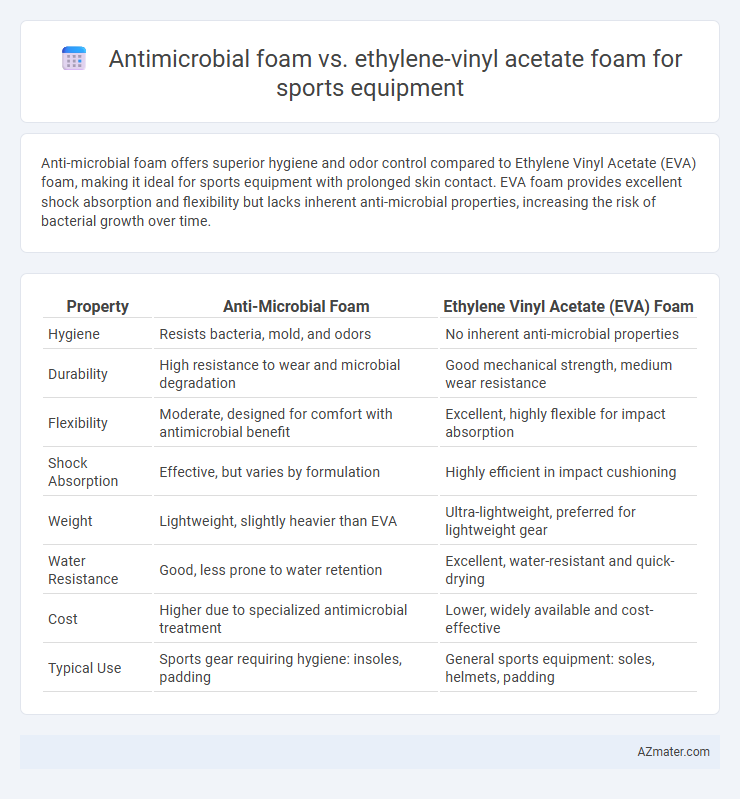Anti-microbial foam offers superior hygiene and odor control compared to Ethylene Vinyl Acetate (EVA) foam, making it ideal for sports equipment with prolonged skin contact. EVA foam provides excellent shock absorption and flexibility but lacks inherent anti-microbial properties, increasing the risk of bacterial growth over time.
Table of Comparison
| Property | Anti-Microbial Foam | Ethylene Vinyl Acetate (EVA) Foam |
|---|---|---|
| Hygiene | Resists bacteria, mold, and odors | No inherent anti-microbial properties |
| Durability | High resistance to wear and microbial degradation | Good mechanical strength, medium wear resistance |
| Flexibility | Moderate, designed for comfort with antimicrobial benefit | Excellent, highly flexible for impact absorption |
| Shock Absorption | Effective, but varies by formulation | Highly efficient in impact cushioning |
| Weight | Lightweight, slightly heavier than EVA | Ultra-lightweight, preferred for lightweight gear |
| Water Resistance | Good, less prone to water retention | Excellent, water-resistant and quick-drying |
| Cost | Higher due to specialized antimicrobial treatment | Lower, widely available and cost-effective |
| Typical Use | Sports gear requiring hygiene: insoles, padding | General sports equipment: soles, helmets, padding |
Introduction to Sports Equipment Foam Technologies
Anti-microbial foam in sports equipment incorporates agents that inhibit bacterial growth, enhancing hygiene and reducing odor during intense physical activity. Ethylene vinyl acetate (EVA) foam offers lightweight cushioning, shock absorption, and durability, making it ideal for protective gear and footwear. Both foams play crucial roles in improving athlete comfort and preventing injuries through advanced material engineering.
Overview of Anti-Microbial Foam
Anti-microbial foam in sports equipment offers superior resistance to bacteria, mold, and mildew, enhancing hygiene and extending product lifespan. This foam incorporates antimicrobial agents that actively inhibit microbial growth, making it ideal for gear exposed to sweat and moisture. Compared to Ethylene Vinyl Acetate (EVA) foam, which prioritizes cushioning and shock absorption, anti-microbial foam provides an essential health safeguard without compromising comfort.
Properties of Ethylene Vinyl Acetate (EVA) Foam
Ethylene Vinyl Acetate (EVA) foam offers exceptional cushioning, flexibility, and durability, making it ideal for sports equipment such as insoles, padding, and protective gear. Its closed-cell structure provides excellent shock absorption and water resistance, enhancing comfort and hygiene during intense physical activities. EVA foam's lightweight and non-toxic properties contribute to superior performance and safety compared to traditional anti-microbial foams.
Comparative Durability in Sports Applications
Anti-microbial foam offers enhanced resistance to bacterial growth and odor, making it a hygienic choice for sports equipment subjected to frequent use and sweat exposure. Ethylene vinyl acetate (EVA) foam provides superior mechanical durability, impact absorption, and long-term resilience under repeated stress, essential for high-impact sports gear. Comparative durability favors EVA foam for structural integrity and shock resistance, while anti-microbial foam excels in maintaining cleanliness and inhibiting microbial degradation during intense athletic activity.
Hygiene and Odor Control Performance
Anti-microbial foam incorporates biocidal agents that inhibit the growth of bacteria, fungi, and mold, significantly enhancing hygiene and odor control in sports equipment. Ethylene vinyl acetate (EVA) foam offers moderate breathability and moisture resistance but lacks inherent antimicrobial properties, making it less effective at preventing odor-causing microorganisms. For optimal hygiene and sustained odor suppression, anti-microbial foam outperforms EVA foam by maintaining a cleaner surface environment during prolonged use.
Impact Absorption and Safety Features
Anti-microbial foam offers superior hygiene by inhibiting bacterial growth, making it ideal for sports equipment used in high-contact environments, while providing effective impact absorption due to its open-cell structure that disperses energy efficiently. Ethylene vinyl acetate (EVA) foam, known for its durability and lightweight properties, excels in high-impact shock absorption with a closed-cell structure that provides consistent cushioning and enhanced safety features by reducing force transmission to the body. Both foams contribute to athlete safety, but EVA's resilience and energy return make it preferable for protective gear requiring long-lasting impact resistance, whereas anti-microbial foam is favored for maintaining cleanliness alongside moderate impact protection.
Comfort and User Experience Considerations
Anti-microbial foam enhances sports equipment comfort by preventing bacterial growth, reducing odors, and maintaining hygiene, which improves extended wear usability. Ethylene vinyl acetate (EVA) foam offers excellent shock absorption and cushioning, providing durable comfort during high-impact sports activities. The choice between these foams impacts user experience by balancing antimicrobial protection and long-lasting cushioning tailored to specific athletic needs.
Environmental and Health Implications
Anti-microbial foam used in sports equipment contains biocidal agents that inhibit microbial growth, reducing odor and improving hygiene, yet it may release harmful chemicals affecting indoor air quality and pose environmental disposal challenges. Ethylene vinyl acetate (EVA) foam is widely favored for its lightweight cushioning and durability, but its production involves petrochemical processes contributing to carbon emissions and it is non-biodegradable, raising concerns about long-term environmental impact. Choosing between these foams requires balancing antimicrobial benefits against potential chemical exposure and environmental sustainability considerations in manufacturing and end-of-life management.
Cost Effectiveness and Accessibility
Anti-microbial foam offers enhanced hygiene by preventing bacterial growth, making it ideal for sports equipment used in high-contact environments, though it tends to be more expensive than Ethylene vinyl acetate (EVA) foam. EVA foam remains the most cost-effective and widely accessible option due to its versatility, durability, and lower production costs, making it the preferred material for mass-produced sports gear. Manufacturers often balance upfront costs and long-term benefits when selecting foam, with EVA providing greater affordability and availability in global markets.
Choosing the Right Foam for Sports Equipment
Anti-microbial foam offers enhanced hygiene by inhibiting bacterial growth, making it ideal for sports equipment exposed to sweat and frequent use, thereby reducing odors and potential skin infections. Ethylene vinyl acetate (EVA) foam provides superior shock absorption, lightweight durability, and flexibility, crucial for protective gear like helmets and padding. Selecting the right foam depends on balancing antimicrobial properties for hygiene and EVA's impact resistance for safety to optimize athlete comfort and protection.

Infographic: Anti-microbial foam vs Ethylene vinyl acetate foam for Sports equipment
 azmater.com
azmater.com